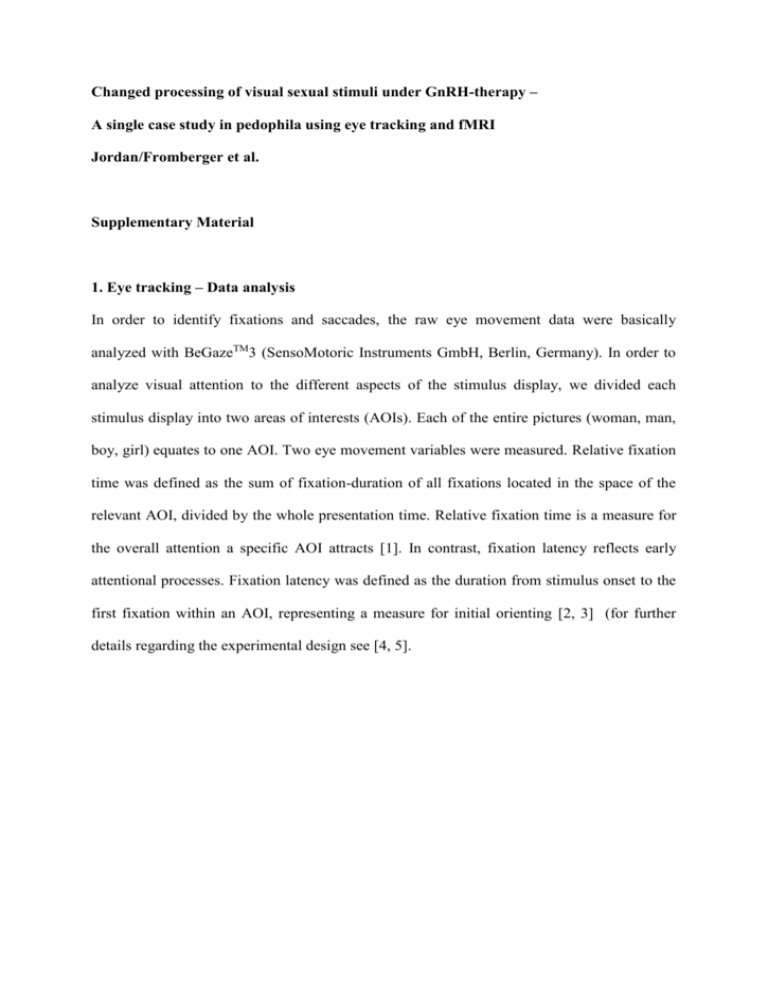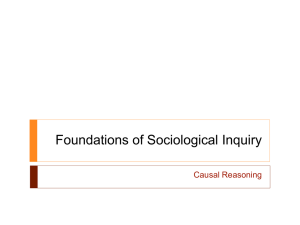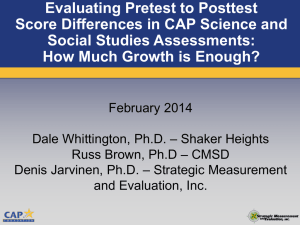
Changed processing of visual sexual stimuli under GnRH-therapy –
A single case study in pedophila using eye tracking and fMRI
Jordan/Fromberger et al.
Supplementary Material
1. Eye tracking – Data analysis
In order to identify fixations and saccades, the raw eye movement data were basically
analyzed with BeGazeTM3 (SensoMotoric Instruments GmbH, Berlin, Germany). In order to
analyze visual attention to the different aspects of the stimulus display, we divided each
stimulus display into two areas of interests (AOIs). Each of the entire pictures (woman, man,
boy, girl) equates to one AOI. Two eye movement variables were measured. Relative fixation
time was defined as the sum of fixation-duration of all fixations located in the space of the
relevant AOI, divided by the whole presentation time. Relative fixation time is a measure for
the overall attention a specific AOI attracts [1]. In contrast, fixation latency reflects early
attentional processes. Fixation latency was defined as the duration from stimulus onset to the
first fixation within an AOI, representing a measure for initial orienting [2, 3] (for further
details regarding the experimental design see [4, 5].
2. IAPS-stimuli
Table 1 presents the neutral masking stimuli selected from the IAPS-set (International
Affective Picture Set. Picture-number, mean (M) and standard deviation (SD) for the ratings
of valence and arousal (male subjects, 9-point likert scale: 1= negative valence/low arousal,
9=
positive
Description
valence/high
Picture No.
arousal)
Valence
M
are
given
Arousal
M
SD
[6].
SD
Flowers
5731
5.19
1.62
2.44
1.87
Plant
5740
5.07
1.27
2.36
1.77
Spoon
7004
4.89
0.6
2.09
1.75
Bowl
7006
4.65
1.1
2.08
1.58
Basket
7010
4.95
1.43
1.55
1.36
Fan
7020
5.02
1.22
2.15
1.71
Mug
7035
4.81
1.05
2.56
1.8
DustPan
7040
4.72
1.19
2.46
1.86
Fork
7080
5.43
1.26
1.98
1.63
Book
7090
4.95
1.54
2.3
1.9
Hammer
7110
4.51
1.02
1.91
1.39
Lamp
7175
4.78
1.18
1.55
0.96
AbstractArt
7185
4.84
1.07
2.56
2.13
AbstractArt
7187
4.87
1.12
2.16
1.63
ClothesRack
7217
4.63
1.15
2.31
1.64
Plate
7233
5.01
1.21
2.51
1.74
Cabinet
7705
4.75
0.79
2.4
1.78
Tissue
7950
4.62
1.26
2.3
1.89
3. fMRI – Data analysis
Image analysis was performed using Statistical Parametric Mapping (SPM8, Wellcome Trust
Center for Neuroimaging, http://www.fil.ion.ucl.ac.uk/spm/). The same preprocessing steps
were applied separately for pre- and post-measurement. Functional images were corrected for
motion artifacts. The structural image of the patient was coregistered to his mean functional
image. The automated segmentation algorithm provided by SPM8 was applied for
segmentation and normalization of the structural image. Functional images were normalized
into a common stereotaxic reference space (International Consortium for Brain Mapping:
http://www.loni.ucla.edu/ICBM/) using the normalization parameters determined from the
segmentation of the structural image (isotropic voxel= 3.2*3.2*3.2mm). Spatial smoothing
was applied using a 7 mm full-width at half-maximum Gaussian kernel. For statistical
analysis a combined design matrix was generated for the pre- and post-measurement sessions.
A general linear model (GLM) was built separately for each session with a fixed effects
approach, containing the regressors of interest, e.g. the different target stimuli categories as
well as one for each of the six rigid-body movement parameters determined from the
realignment procedure. The resulting set of voxel values for each contrast constitutes a
statistical parametric map of the T-statistic (SPM(T)). According to our hypotheses we were
mainly interested in changes in hemodynamic responses under the antiandrogen therapy.
Therefore, the contrasts of interest were the differential effects between the pre- and postmeasurement for the pictures of girls and women separately. The statistical threshold was set
to p<.01 (uncorrected for multiple comparisons) and a spatial extend of k=5 voxels. This
liberal threshold was used according to the expected small differences in hemodynamic
responses of two types of subliminal presented pictures, and the special situation of one single
case. For each condition (girl pictures, woman pictures) we separately examined which brain
regions showed a stronger activation in the pretest compared to the posttest and which brain
regions showed a stronger activation in the posttest compared to the pretest. Therefore we
applied one-sided T-tests (typical SPM T-contrasts) and used an inclusive masking procedure.
Table 2 presents the four analyzed SPM T-contrasts as well as selected masking contrasts. In
the following we describe this procedure in detail for one analyzed comparison: To analyze
which brain regions were stronger activated during the subliminal presentation of girl pictures
in the pretest compared to the subliminal presentation in the posttest, we computed the SPM
T-contrast girl-pretest versus girl-posttest using the statistical threshold p<.01 (uncorrected for
multiple conditions) and a spatial extend of k=5 voxels. In order to restrict our analysis to
those brain regions which were activated in the pretest, we applied an inclusive spatial
masking procedure, using the SPM T-contrast for the subliminal presentation of the girl
pictures in the pretest (girl-pretest) as masking image with a statistical threshold of p<.05
(uncorrected for multiple comparisons). Voxels outside of the mask were excluded from the
analysis. This procedure was applied for each of the four analyzed contrasts using the
individual masking images (see Table 2).
Brain regions were identified using probabilistic cytoarchitectonic maps in the Anatomy
Toolbox
1.8
implemented
in
SPM8
(http://www.fz-juelich.de/inm/inm-
1/DE/Forschung/_docs/SPMAnatomyToolbox/SPMAnatomyToolbox_node.html) [7, 8].
Table 2: Statistical analysis of the fMRI-data. Comparisons of interest, computed SPM Tcontrasts and masking images.
Comparison of interest
computed T-contrast
Inclusive masking
contrast
Girl
pictures:
activation
in
Stronger Girl-pretest > Girl-posttest
the
Girl-pretest
pretest
compared to the posttest
Girl
pictures:
activation
in
Stronger Girl-posttest > Girl-pretest
the
Girl-posttest
posttest
compared to the pretest
Woman
activation
pictures:
in
Stronger Woman-pretest > Woman- Woman-pretest
the
pretest posttest
compared to the posttest
Woman
activation
pictures:
in
the
compared to the pretest
Stronger Woman-posttest > Woman- Woman-posttest
posttest pretest
References
1.
2.
3.
4.
5.
6.
7.
8.
Ellis SR, Smith JD: Patterns of statistical dependency in visual scanning. In Eye movements
and human information processing. Edited by Groner R, McConkie GW, Menz C. Amsterdam:
Elsevier; 1985: 221-238
Caseras X, Garner M, Bradley BP, Mogg K: Biases in visual orienting to negative and positive
scenes in dysphoria: An eye movement study. Journal of Abnormal Psychology 2007,
116:491-497.
Gao X, Wang Q, Jackson T, Zhao G, Liang Y, Chen H: Biases in orienting and maintenance of
attention among weight dissatisfied women: an eye-movement study. Behavior Research
and Therapy 2011, 49:252-259.
Fromberger P, Jordan K, von Herder J, Steinkrauss H, Nemetschek R, Stolpmann G, Müller JL:
Initial orienting towards sexually relevant stimuli: Preliminary evidence from eye
movement measures. Archives of Sexual Behavior 2012, 41:919-928.
Fromberger P, Jordan K, Steinkrauss H, von Herder J, Witzel J, Stolpmann G, Kröner-Herwig B,
Müller JL: Diagnostic accuracy of eye movements in assessing pedophilia. The Journal of
Sexual Medicine 2012, 9:1868-1882.
Lang PJ, Bradley MB, Cuthbert BN: International Affective Picture System, 2001. NIMH
Center for the Study of Emotion and Attention: University of Florida, Gainesville, FL 2001.
Eickhoff SB, Stephan KE, Mohlberg H, Grefkes C, Fink GR, Amunts K, Zilles K: A new SPM
toolbox for combining probabilistic cytoarchitectonic maps and functional imaging data.
Neuroimage 2005, 25:1325-1335.
Eickhoff SB, Heim S, Zilles K, Amunts K: Testing anatomically specified hypotheses in
functional imaging using cytoarchitectonic maps. NeuroImage 2006, 32:570-582.







